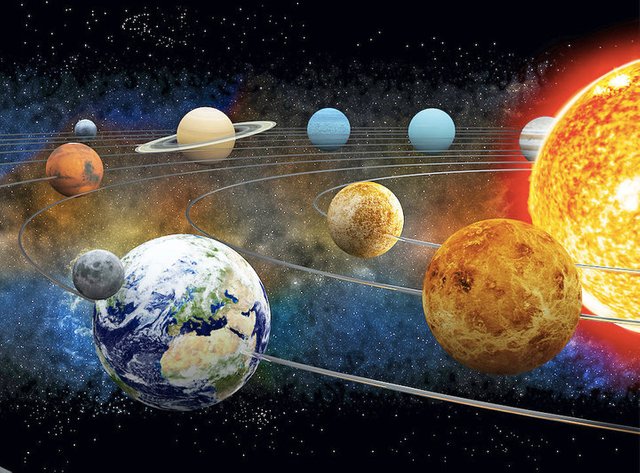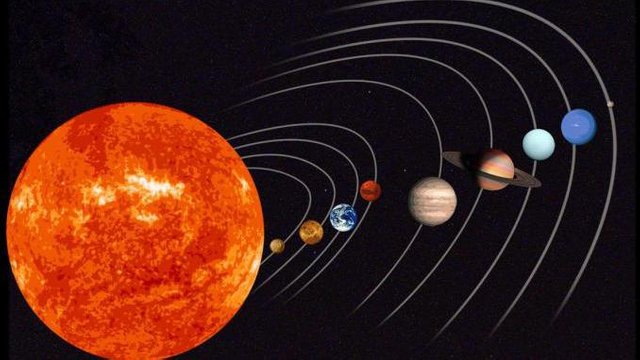50 Facts About Our Solar System that will leave you speechless. Part 2...!

1. Do you know that Venus is the only planet in our Solar System that rotates in the opposite direction of any other planet? Venus is a real rebel. Now understand why they say that women are from Venus ...
2. Here's a fun fact: One day at Venus is, in fact, longer than his year. Venus needs much more time to rotate around its axis than around our Sun.
3. Saturn's moon, Titan has an atmosphere very similar to Earth's atmosphere. Titan's atmosphere is twenty percent larger than the Earth's atmosphere.
4. Scientists suggest that given the similarities with the Earth, there may be biological activity; making it an ideal place to seek life outside the Earth.
5. Ganymede, Jupiter's natural satellite is considered the largest natural satellite in our solar system and has a diameter of 5,268 km, which is 8 percent bigger than that of the Mercury planet.
6. The diameter of Ganymede is 2% larger than that of Saturn Titan, which is the second largest moon.
7. Do you know that Ganymede, Jupiter's largest and most massive moon, has the highest mass of all planetary satellites? It has 2.02 times the magnitude of the Earth's moon.
8. Ganymede is the only one in the solar system known to possess a magnetosphere which is a space near an astronomical object where charged particles are controlled by the magnetic field of that object.
9. Saturn's Mimas Moon is one of the heaviest objects of the Solar System, likewise resembling the "Star of Death" (the fictional space station known by the film Wartime Wars, Episode IV: A New Hope) due to the giant crater, 130 miles wide.
10. Mimas is the smallest astronomical body known to be rounded in shape due to self-gravitation.
11. Asteroid 243 Ida has a satellite around him, called Dactyl. 243 Ida is also one of the shorter objects in the solar system.
12. The largest dwarf planet that orbits our Sun is called Eris, orbiting the Sun at three times the distance of Pluto.
13. Eris was recently discovered (2005) and is the ninth most massive body known to revolve around the Sun.
14. Eris is estimated to be 27 percent bigger than Pluto, but there is uncertainty about its size; to calculate it properly, more research is needed.
15. Dysnomia is by far the only known natural moon of Eris, its diameter is estimated to be between 350 and 490 km.

16. Saturn's Hyperion Moon is the largest non-spherical moon in our solar system.
17. In its composition, Hyperion has a half density of water, which means it would float if placed in the water (hypothetically).
18. Astronomers believe that Hyperion is a fragment of a much larger object that was destroyed in the distant past, thus taking its own irregular shape.
19. The Hyperion surface contains a large amount of deep craters, which together with its irregular shape, give the moon the appearance of a giant sponge.
20. Ceres is by far the only known dwarf planet set in the interior of the solar system and is closer to the Sun than Neptune.
21. It is considered the largest asteroid in the interior of our solar system.
22.Researchers estimate that Ceres contains an internal ocean of liquid water under its surface.
23. This dwarf planet contains more fresh water under its surface than all the fresh water on Earth taken together.
24. Sedna, a large planetoid is the first dwarf planet discovered in the cloud of Oort.
25. In the obvious light, Sedna is one of the most reddish objects in the solar system.
26. Sedna is one of the most remote objects known in the Solar System.
27. Sedna makes the longest spin on the Solar System, its orbit lasting 11,400 years to complete.
28. 2012 VP113 is a planetoid that has the most known perihelion - (the closest approach to the Sun). Researchers suggest that 2012 VP113 is about half the size of Sednas.
29. There are four objects in our solar system that have perihelia larger than 47 astronomical units; Sedna, 2010 GB174, 2004 XR190 and 2004 VN112.
30. Olympus Mons, located on Mars is actually the largest volcanic mountain that is discovered in our solar system.
31. Mars has water; Scientists have discovered traces of water in Mars but not in liquid form.
32. Komak Hyakutake is believed to have had the longest lap ever discovered, over 570 million km in length.
33. Do you know that Uranus is the only known planet in our Solar System that actually revolves around?
34. Think about it, if you crawl into space, no one will hear. This is because there is no air in the space, which means that nothing can convey your voice, so even if you exclaim or speak, no one would be able to hear you.
35. Researchers find it difficult to explain Mars, Deimos and Phobos, some even theorize that these moons are blocked in the orbit of Mars.
36. Phobos will probably collapse one day on Mars. Because of the extremely low orbit, tidal forces are slowly lowering Phobos's orbit. Astronomers have estimated that in about 50 million years, this moon will fall into the red planet.
37. Surprisingly, Mercury and Venus are two planets in our solar system that have no moon that surrounds them.
38. Do you know that the Earth's moon has water? Astronomers suggest that water in the form of ice may be present in the craters on the moon.
39. We have researched our solar system considerably in recent years. But despite this fact, Mercury is less explored by planets in our solar system.
40. Do you know there are more than 500,000 small planets discovered and cataloged by the Planet Center?
41. Venus, except that it is the hottest planet, is also the most dangerous planet in its atmosphere filled with sulfuric acid.
42. Despite the fact that there is a great possibility that hundreds of dwarf planets exist on the Kuiper belt, the International Astronomical Union has only received four: Pluto, Eris, Haumea and Makemake.
43. Astronomers believe that more than 50 tons of spatial stones and dust fall on Earth every day.
44. One day in Mercury is equal to 58 days on Earth.
45. Gravity on our planet is six times stronger than on the surface of the moon; this means that you will weigh less on the moon than on Earth.
46. Magnetosphere is one of the main reasons why life can exist on our planet. It helps to divert harmful radiation from the Sun, far from Earth.
47. Experts do not fully understand Saturn's Rings. Some astronomers believe they may be too old and may have existed since the beginning of the solar system. However, there are others who believe they can be relatively new ... compared to the age of the planet.
48. Astronomers believe there is a great chance to have life on Saturn's moon, Enceladus.
49. Mars, a planet that is very similar to Earth has the largest dust storms in the solar system, they can last for months and cover the entire planet.
50. The age of the solar system, derived from the study of meteorites (thought to be the oldest accessible material around) is near 5 billion years; that of the Earth is taken as 4.6 billion years. The oldest rocks on Earth are dated as 3.8 billion years. Some of these ancient rocks already have signs of advanced life forms, so-called "chemical fossils", mineral matter that has odd properties thought to result from life processes.

Resources: Space.com, Science National Geographic, NASA Solar System

Thank you very much to every single follower and all steamians who support me.
Also big thanks goes to @busy.org & @busy.pay for huge support to minnows like me and so many other minnows of the steemit community .
So join https://busy.org and lets make steemit community better together.
You can also join me at: https://busy.org/i/@helamia
Take some time to check more of my blogs. You might find something that interests you or learn something new. Best regards from @helamia .
If you wish to contact directly or just want to add me. Follow the links below where u can add / follow me:
https://web.facebook.com/Hilmi.Bojaxhiu
https://www.instagram.com/hilmibojaxhiu/
https://twitter.com/HilmiBojaxhiu
You got a 73.17% upvote from @bid4joy courtesy of @helamia!
Hi, I found some acronyms/abbreviations in this post. This is how they expand:
At first thanks for stopping by. Second thanks for your opinion. Third i do not upvote comments that much because i save my up-vote for people who make good content and i up-vote back to some of my respective followers.
You got a 38.46% upvote from @cabbage-dealer courtesy of @helamia!
Earn daily rewards by delegating to @cabbage-dealer.
You just received a 41.10% lifting from @botox ! You can also earn by making delegation to @botox.
Tu viens de recevoir un lifting de 41.10% de la part de @botox ! Tu peux également être récompensé en faisant de la délegation à @botox.
You got a 60.00% upvote from @profitbot courtesy of @helamia!
Join our team and delegate your SP to earn passive income.
Get part of 85% @profitbot profit based on your delegated SP
by clicking on one of the ready to delegate links:
10SP|20SP|50SP|75SP|100SP|200SP|300SP|500SP|1000SP|custom
You got a 50.00% upvote from @redwhale thanks to @helamia!
Earn 85% earning payout by delegating SP to @redwhale
If you are looking to earn a passive no hassle return on your Steem Power, delegate your SP to @redwhale by clicking on one of the ready to delegate links:
25SP | 50SP | 75SP | 100SP | 250SP | 500SP | 1000SP | 2500SP | 5000SP Another Amount
You will earn 85% of the voting bot's earnings based on your delegated SP's prorated share of the bot's SP each day! You can also undelegate at anytime.
Our Discord Channel: https://discord.gg/ttaypWb
You got a 41.71% upvote from @stef courtesy of @helamia!